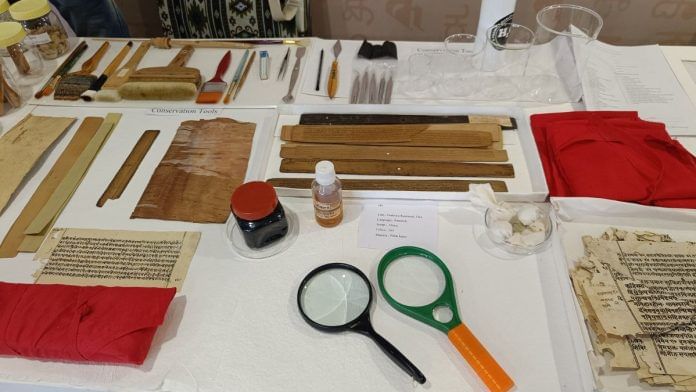New Delhi: The digitisation of India’s manuscript heritage just got a leg-up. The Narendra Modi government has signed agreements with 17 institutions across the country, a month after the Gyan Bharatam International Conference on reclaiming India’s knowledge legacy through manuscript heritage.
During a ceremony at the National Gallery of Modern Art (NGMA) on Saturday, MoUs were exchanged in the presence of Union Culture Minister Gajendra Singh Shekhawat.
Among the 17 institutions, 12 have entered into the agreement under the ‘cluster’ category, while the other five will function as independent centres.
“The institutions are from all parts of the country such as Kashmir, Chennai, Himachal Pradesh, Bihar to Bengal. It aims to disseminate the knowledge from different parts of the country and preserve it for future generations,” said a senior culture ministry official.
The official said that the government wants to digitise the manuscripts as early as possible. “In the coming weeks, we will sign pacts with more institutions, which have significant collections of manuscripts.”
Under the Gyan Bharatam framework, these centres will undertake key tasks such as survey and cataloguing, conservation and capacity building, technology and digitisation, linguistics and translation, and research, publication, and outreach.
“Ensuring both regional coordination and institutional autonomy in the mission to rejuvenate India’s manuscript heritage,” reads the government statement.
This is part of the Modi government’s flagship Gyan Bharatam programme, aimed at preserving and promoting India’s rich intellectual heritage. It replaced the existing National Mission for Manuscripts, which was launched in 2003 during the Vajpayee government.
Finance Minister Nirmala Sitharaman announced the Gyan Bharatam Mission in the Union Budget 2025-26, under which over one crore manuscripts will be conserved and documented. In this year’s Independence Day speech, PM Modi mentioned the Gyan Bharatam Mission.
According to Shekhawat, the tie-up with institutions will strengthen the campaign to preserve, digitise, and disseminate ancient manuscripts.
“It is our primary objective that today’s youth and future generations benefit from this immense heritage of India, know their roots, and take pride in it and carry it forward. It is also an effort to comprehensively showcase India’s intellectual heritage to the world,” Shekhawat posted on X.
17 institutions with one goal
In his address, Shekhawat said it was not just another signing ceremony, but a step toward expanding the family of the ministry which has taken up this key mission.
The institutions that have signed MoUs with the government are the University of Kashmir’s Department of Persian, Asiatic Society of Kolkata, Nagari Pracharini Sabha in Varanasi, Himachal State Museum in Shimla, Central Institute of Buddhist Studies in Leh, Assam University, and Nava Nalanda Mahavihara in Bihar.
“These institutions have a rich repository of manuscripts. Now these institutions will work together with the central government to preserve the heritage,” said an official in the culture ministry.
At the three-day international conference, titled Reclaiming India’s Knowledge Legacy Through Manuscript Heritage, held at Delhi’s Vigyan Bhawan last month, the representatives of these institutions gave their recommendation to the government in the presence of PM Modi.
The Asiatic Society manuscripts division has four sections, such as Sanskritic section, Islamic section, Sino-Tibetan and South-East Asian section, and English section.
The manuscripts in the Sanskritic section cover the period from 7th c. A.D. down to the 19th century. These are useful source materials to illustrate the development of Indian scripts such as Bengali and Nagari.
“The Society has manuscripts on Ramayana, Mahabharata, Srimadbhagavat, Mangala Kavyas, treatises on Vaisnava faith and its allied subjects. Folk literature, erotic verses and Vaisnaba Sahajiya Cult,” the website states.
The Nagari Pracharini Sabha in Varanasi has a catalogue of rare Hindi manuscripts. The University of Kashmir has more than 5,500 manuscripts. Different scripts such as Nastaliq, Naskh, Sarda, Devanagari were used for writing these manuscripts.
The Central Institute of Buddhist Studies in Leh has a collection of 37,722 manuscripts from 2,389 different monasteries, palaces, and individuals of Ladakh region.
At the Gyan Bharatam conference last month, PM Modi said India is witnessing a renaissance of its glorious past.
“This mission is not a government or academic event. It is going to be the proclamation of India’s consciousness,” said Modi.
(Edited by Aamaan Alam Khan)






